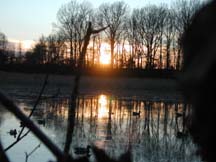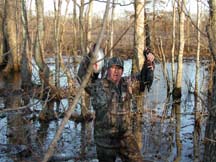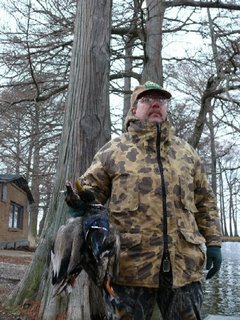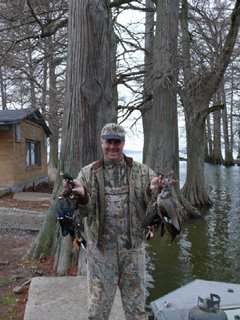THE BEAST OF BAYS MOUNTAINBy Mike Faulk The rain began Wednesday night.
It was one of those bone-chilling drizzles that sets-in for days in the winter of the southern Appalachians. Temperatures don’t quite go below freezing; but, might as well. Those with arthritis know the type rain I describe and the aching it triggers.
Clouds delivering this weather seem to cling to the ground. Other than the precipitation they bring, these clouds could easily be confused with fog. And they make it dark – even in the middle of the day.
The boat ride to the cabin Friday evening was miserable. With temperatures hovering just at 32 degrees, it should have been snowing; but, it wasn’t. Instead we had freezing rain – the stuff that falls as liquid but becomes solid ice when making contact with cold objects – like the jon boat.
Weather forecasters predicted an end to these hostilities in the wee hours of the morning.
It would take most of the night for the fireplace and propane space heaters to get the cabin comfortable. Were the rain to let up, wildlife of all types would be on the move at first light. They, too, had been locked down since Wednesday. If the rain didn’t let up, it was going to be a fine morning to sleep in.
I consider it a treat to spend time at the cabin even in nasty weather. The cozy factor is especially high in inclement weather. Since there was some chance the rain would turn to snow overnight, my excitement level was also high. I love to hunt in a fresh skiff of snow. It takes me back to those Faulk-boy rabbit hunts of my youth.
There was no pressure to kill a deer this weekend. Brother Loy took the largest deer any of the regulars had ever harvested on Strum Island two weeks ago during muzzleloader season. The perfectly shaped rack of the 8 point buck was so very, very wide. Ones thumb and forefinger could not touch in trying to hold the main beam of the antlers. The gross weight of the animal far exceeded two hundred pounds. He was a hoss. There would be plenty of shared venison for months to come.
Answering the 4:45 a.m. alarm, I arose to immediately check the weather and temperature. The sound from the tin roof told me it was either raining lightly or something was dripping off the main roof down onto the porch roof. The flashlight illuminated a thermometer outside the kitchen window that beaconed a balmy 34 degrees. There was no snow on the ground.
A good friend gave me a Garmin handheld weather station for Christmas a few years back. It showed the barometer had steadied. I ventured onto the porch and learned the noise from the roof was run-off. The cloud cover or the fog was right on the ground. The woods’ edge was not visible and certainly the lights from distant farm houses were obscured.
Having made the decision to hunt rather than sleep, I donned my hip waders and backpack, clipped on my cap-bill light, and made the seven minute walk from the cabin to the sluice duck blind.
River fog seems to have no compass of its own. It moves first in one direction then the other. Aided on this morning by the transient fog, the darkness seemed to hang on well past daybreak. At times I was able to glass the flat to the north of my perch in the blind.
Most likely I was going to have to depend on my hearing for success. Subtle changes in the sound of running water would be the only clue I would have in advance of a deer wondering out into the river and into range.
Leupold’s Wind River binoculars are superb. The wide field of vision seems to let all available light into the recticle – evening my odds on days like this. However, the best optics can’t pierce Holston River-bottom fog. Scanning the flat and ridges was clearly a hit-and-miss proposition.
On one of my binocular sweeps across the river bottom hardwoods, I saw a bit of white in an out-of-place place. The harder I concentrated on looking to see what this aberration was, the thicker the fog became until I could no longer see. Finding the same spot a second time was not guaranteed.
When the flat was again revealed by the ever-mobile fog, I searched the area and saw the hind quarter of a deer – a huge deer. The head and front half of the animal was obscured by weeds. In the dimmest of light I could tell it was oblivious to my presence as it grazed on some greens.
By sheer will-power I tried to keep the fog at bay long enough to get a look at the rest of this animal. I was fighting a losing battle; or so I thought.
Canting every so slightly to its left I saw the girth of this creature. It was a third again as big as the deer Loy killed only days before. I helped carry that deer out of the woods to a point where it could be field dressed. Having a recent basis for comparison, I knew I was staring at a monster.
The body mass foreshadowed the antlers. Twisting his head to the left and pulling some plant out of the ground, the buck revealed the left main beam. It was milky white. At the point where the first tine above the brow tine branches off, the antler beam was not cylindrical but was instead oval shaped and wide.
In awe, I could hear a voice in my head: “brow tine – that’s one, 12 to 14 inch T-2 – that’s two, 9-10 inch T-3 – that’s three, 7-8 inch T-4– that’s four, 6 inch T-5 – that’s five, 4 inch T-6 – that’s six . . . “ And then with an eerie clarity I’ll never for the rest of my life forget, that same inner-voice that was doing the counting of antler points said, “You might want to look at all those points through your scope instead of your binoculars!”
In a panic and in obeyance to the inner-voice, I eased the binoculars down. With abundant caution I took the one step from my seat to get my rifle. I remained low using the side of the blind to shield me from the deer. I securely gripped the rifle and reversed course. Gently I reclaimed my seat. Before shouldering the rifle, I took the obligatory deep breath. This would be the deer of a lifetime. It would most surely make Boone and Crockett. I shouldered the weapon and opened my right eye to see the Beast of Bays Mountain through my scope.
No more than thirty seconds had elapsed from the time the inner voice admonished me to get my gun and the time I looked through the scope rather than the binoculars. In those thirty seconds, the fog had returned. I steadied the rifle in the general direction of the deer. I reconfirmed the magnification power was at its lowest so I’d have the broadest field of vision when the fog cleared.
Seemingly like an eternity, the fog did, indeed, clear in only a minute. The beast had disappeared. I scoured that flat for half an hour. There was nothing where moments before there had been the biggest whitetail deer I had ever seen in my lifetime – either on television or in the field. Even the fog was now gone.
That deer profoundly affected me. I have so many wonderful memories from my days in the field. I cherish them all. I enjoy recalling them – even writing about them helps me relive and re-enjoy those good times. But I’ve never had one five-minute segment of my hunting life replayed so many times in my mind.
The Beast of Bays Mountain has gotten inside my head. I have debates with my inner voice demanding to know why it didn’t speak up sooner.
I’m convinced the beast had become completely nocturnal. In those five minutes on that dreary, fog-bound, night-like November morning, when all seemed safe and dark to him, his inner voice - the one that had gotten him to the size and stature of a true giant - said “you are not alone; move on.”
Maybe we’ll see one another again someday – some rainy, cold, miserable black day. Oh what a day that will be! There will be no debate with the inner voice. I’ll be looking at the Beast of Bays Mountain through my scope – not my binoculars.






